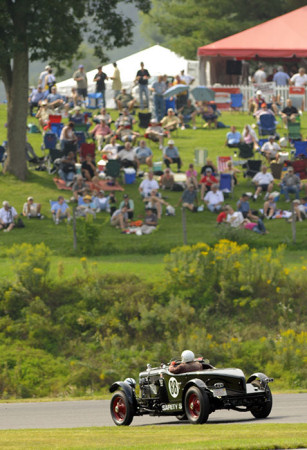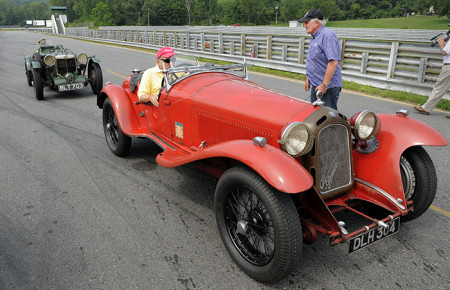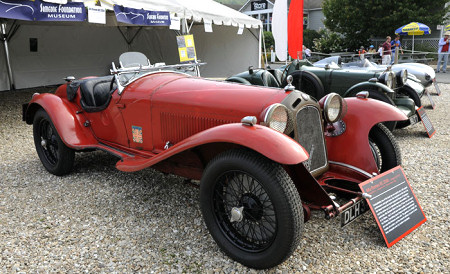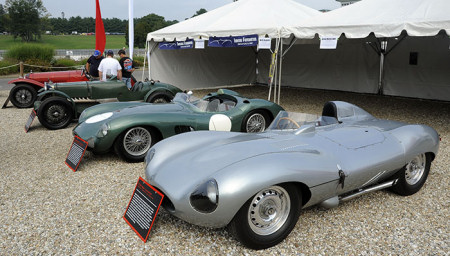The Way It Is/ Lime Rock's delightful vintage festival
by Gordon Kirby Vintage and historic racing has emerged steadily over the past quarter century or more in North America, Europe, Australia and New Zealand as one of the healthiest forms of motor sport. Every permanent road course and some ovals stage annual historic weekends with big competitor turnouts and plenty of enthusiastic fans. The wide variety of vintage shapes and sounds represent the essence of the sport and provide a sharp contrast to the spec car plague which has sadly infected and reduced so many contemporary forms of racing. The spirit of the sport lives on in vintage and historic racing and it's always a pleasure to visit any of these events.
Vintage and historic racing has emerged steadily over the past quarter century or more in North America, Europe, Australia and New Zealand as one of the healthiest forms of motor sport. Every permanent road course and some ovals stage annual historic weekends with big competitor turnouts and plenty of enthusiastic fans. The wide variety of vintage shapes and sounds represent the essence of the sport and provide a sharp contrast to the spec car plague which has sadly infected and reduced so many contemporary forms of racing. The spirit of the sport lives on in vintage and historic racing and it's always a pleasure to visit any of these events.
Lime Rock's labor day weekend vintage festival is a case in point. This was the 29th year for Lime Rock's vintage festival and this year the bucolic road course in northwestern Connecticut was jammed to capacity with more than 300 cars running in ten different categories. Organizer Murray Smith couldn't have been happier and hopes to make next year's 30th anniversary a celebration of the career of one of the sport's greatest living drivers.
"We had a great turnout of cars this year and record crowd, I believe," Smith said. "We did an interview with Bob Tulius on Friday night and he was very warm and open. He talked about many things and left everyone very happy. It was a great evening and really, I don't think the event as a whole could be doing any better. As long as everyone continues to behave themselves on the racetrack we'll continue to go from strength to strength."

© Gary Gold
As well as being a meticulous publisher and editor Freeman is a renowned vintage Indy car collector. Joe was selected as 'collector of the year' at last year's Lime Rock vintage festival and this year's 'collector of the year' was Dr. Fred Simeone who owns a superb collection of 65 classic sports/racing cars which are displayed at the Simeone Foundation Automotive Museum in Philadelphia.
Simeone was a neurosurgeon who retired three years ago to run his museum which is located behind the Philadelphia Airport Auto Mall just off Interstates 76 and 95 and is open six days a week from Tuesday through Sunday. For more information call (215) 365-7233 or go to www.SimeoneMuseum.org. At Lime Rock he told me how he became an enthusiast of the world's great long-distance sports/racers.
"My dad was a general practitioner and we would make house calls together and go to junk yards," Simeone recalled. "In those days in the '60s you could get some very special cars from junkyards. My dad would buy Auburns and sometimes Duesenbergs. Because of him I developed a sense of what's important and then I started collecting books and learning more and more about historic and vintage cars. I scrimped and saved to buy cars and traded away some wonderful cars to get better cars. I traded an A6CTS Maserati to get a Cobra Daytona Coupe. It hurt me, but that was the only way I could get the Cobra.
"I only care about racing sports cars and road racing," Simeone added. "Roundy-round racing is not interesting to me. Great racing sports cars is my focus--the Mille Miglia, the Targa Florio, Le Mans, Sebring and the Nurburgring 1000Ks--the great long-distance sports car races."
Simeone brought four of his prized sports/racers to Lime Rock--a 1934 Alfa-Romeo 8C2300, 1934 MG Magnette, 1955 Jaguar D-Type and a 1958 Aston-Martin DBR1--and he told me the story of each of these cars.
"The Alfa is a very interesting car," Simeone began. "It's a short-chassis Mille Miglia Spider and the only one that was bodied by Castagna. Many people think it's prettier than the Zagato-bodied car. I prefer the touring car to this, but I prefer this to the Zagato.
"It was owned and raced by Alfa Romeo and raced in the 1934 Mille Miglia," he went on. "Then it came to England and how it got to England is still a mystery, although it's covered fairly well in Simon Moore's book, 'The Legendary 2.3'. It ended up in Guy Templar's hands. He was one of the original Brooklands guys. He was very keen and loved the car. In fact, there's a plaque on the right front fender that was put on at Brooklands that says this car did 135 mph on Brooklands' outer circuit, which was a pretty exciting thing for a car from 1934.
"In 1939 there was a famous race held at Brooklands called the 'World's Fastest Sports Car Race'. It was written about by a journalist named Dugdale and included Rob Walker's Delahaye 138 and Hugh Hunter's 8C2900 Alfa Romeo--the Mille Miglia winner--and Guy Templar's car was there competing. Hugh Hunter's car led the race but faltered and the Delahaye won.

© Gary Gold
"Then he saw an advertisement in a British journal that it was for sale. So he cabled the owner saying he wanted to buy the car and then flew to England and reached the owner before the cable arrived! So Ed Bond bought the car again and brought it back to America. It passed through another owner and I bought it from Peter Giddings in 1970.
"It's been mechanically restored but we have not repainted or reupholstered the car. Some of the upholstery is new but some of it is original. The engine has always been bullet-proof and we've done nothing to it but keep it running. It will stay in the condition it's in as a car with a real life behind it."
Simeone explained his philosophy, particularly pertaining to his Alfa Romeo and MG.
"If anything characterizes our museum it's a philosophy that the cars should be kept as found," he stressed. "About a third of our cars are that way. I run the Alfa all the time. The museum has three acres of blacktop which we use as a track. On Saturdays we'll take out some cars and run them around so the cars get driven. We've taken the Alfa to the (historic) Mille Miglia three times and we drive it regularly, but we don't race it.
"I believe that if it's an important historical car of which there are not many examples you shouldn't be racing it anymore. Some of the Brit collectors in particular don't subscribe to that theory. They believe the cars should be driven, but my answer is you have to decide if it's about you or about the car. If it's about you then take it out and beat it to hell. But if it's about the car lasting for generations, or decades, or even centuries, then you should try to preserve it.
"That's an argument that will continue to rage long after I'm gone. But from my point of view, I think it would be a pity to take these two cars and make them shiny."
Simeone then turned to his 1934 MG.
"The MG K3 always fascinated me because it was a small car, by far the smallest car in our collection. Every unsupercharged car we have is over two liters. We collect the cars that really made a name for themselves at the Mille Miglia, Targa Florio, Le Mans, Sebring and so on, so they're all big displacement cars. But this MG with only 1,100 cc supercharged was up there with the big boys.

© Gary Gold
"It also did the 1935 Le Mans race but didn't finish. It went through one or two owners and then went to Canada and the story as I understand it is that the Canadian owner gave it to an American to restore and there was a dispute. The restorer didn't get paid so there was a stand-off and the restorer would not return it to Canada. That was in 1965 and all the K3 specialists assumed that it had disappeared.
"I happened to see the bonnet offered for sale and the bonnet had two gussets or holders for the leather hood straps. Well, the normal MG K3 had a single, center strap holder. If it had two straps it had to have been done for Le Mans. There was no other reason to have two straps on the bonnet other than the Le Mans regulations required two hood straps.
"So I immediately bought the bonnet and traced it back and found out that the car was being sold off in pieces. I managed to buy the rest of the car. I told the guy that owned it that we were going to assemble the car. I told him we were not going to restore it. And that's what we did. We assembled the car and filled in some of the spots on the bodywork. Every piece was there and now it runs great.
"It smokes a bit because the supercharger has a magnesium case made strictly for racing and we over-oil it to preserve the case. But it's a wonderful running car. It's totally original. The only thing that's been redone are the seats, which were done by the restorer, and some paint we spotted-in. Other than that it just had to be fettled because it was in really good shape."
Simeone next discussed his silver Jaguar D-Type.
"The D Jaguar was brought into America by a man named Jack Hensley who represented a Jaguar distributor in the Midwest. The interesting thing about the car is it goes back to 1955 when the car came to America. A handsome young man named Bob Sweikert won the Indianapolis 500 that year. That was the worst year in racing, of course, with the Le Mans disaster and Bill Vukovich being killed at Indianapolis. Only a few years later about half of the drivers in the '55 Indianapolis 500 had been killed in racing.
"Anyway Jack Hensely asked Bob Sweikert to drive his D Jaguar at Sebring in '56. Sweikert didn't know how to drive a road racing car but Hensley taught him and they came in third at Sebring. Sweikert was killed shortly after that and his wife, who was a beautiful, movie star type young woman, wrote a book called 'Along for the ride' about her life with Sweikert and how much he loved cars and racing and her own personal tragedies, including his death.

© Gary Gold
Simeone's Aston-Martin DBR1 has been superbly restored and may well be the pride of his collection.
"I never believed I would own the Aston," he remarked. "It's a beautiful car and when I give tours at the museum it pains me to say it's the prettiest of the '50s sports we have in our collection because I'm Italian and it's a British car. I have a Testa Rossa and a 300S Mercedes but this car is prettier than either of them. It's also better-balanced and has better brakes and a great engine.
"They made four of these for the factory and a fifth was built for a privateer. All four of the factory cars had great histories in 1958 and '59. Of course, in '59 they were competing against the factory Ferrari team, a big, expensive team, and Aston Martin won the world championship. Carroll Shelby and Roy Salvadori won Le Mans and this car won the Nurburgring 1000Ks in 1958 with Stirling Moss driving. All four of the works Astons had wonderful histories.
"After 1959 David Brown stopped sports car racing and Border Reivers bought this car. Jimmy Clark was just starting to drive and he raced this car at Le Mans in 1960 and '61 and finished third in 1960. It caught on fire at Goodwood and was restored very carefully with extreme attention to detail. They spent hundreds of hours restoring the cylinder head and it's a wonderful car to drive. We run this car once every two to three months. When the Border Reviers had it this car was dark blue but we brought it back to Nurburgring 1958 specification."
Simeone closed by noting the stratospheric rise in price in recent years of so many vintage and historic cars.
"As you know, the price of so many of these cars has gone through the roof in recent years. I just couldn't afford many of the cars in my collection if I tried to buy them today. I've built my collection by trading ad selling and I guess I've been lucky because there's no way I could afford these cars on my pension. But they're the delight of my life, a tremendous pleasure."
Fred Simeone is a true motor racing enthusiast. A chance to drop by his museum and enjoy a tour from the man himself is not to be missed. Nor is a visit to your local vintage or historic weekend. It's the finest antidote you'll find for the plague of spec car racing.
Auto Racing ~ Gordon Kirby
Copyright 2011 ~ All Rights Reserved
Copyright 2011 ~ All Rights Reserved
Top of Page